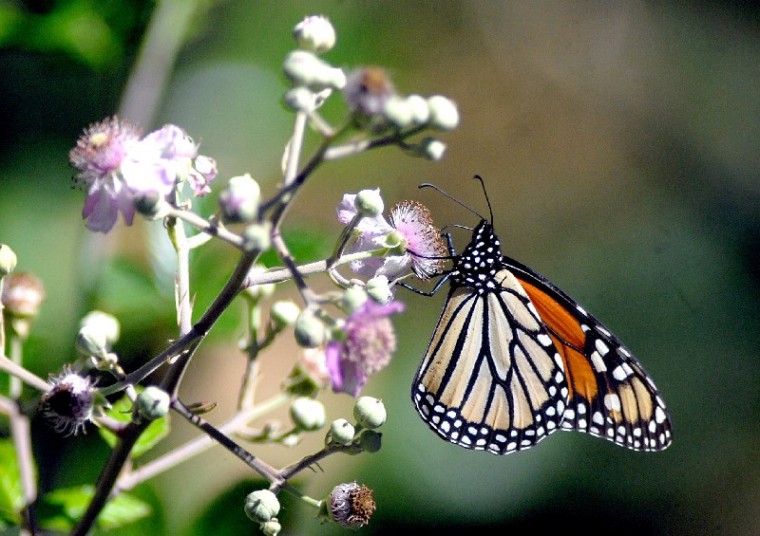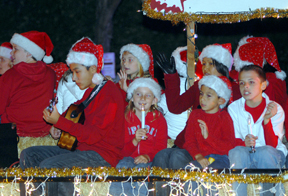Orange and black-winged Monarch butterflies dance silently among
the eucalyptus treetops, buoyed by the cool ocean breezes and
warmed by the October sun as it filters through a grove at Natural
Bridges State Park in Santa Cruz.
Visitors look skyward through cameras and binoculars as they
meander along the Monarch Butterfly Boardwalk, a wooden structure
that winds gently down a hill into the heart of one of the best
spots to view these winged wonders on their annual migration to the
Central Coast.
Butterflies return to winter homes on the coast
Orange and black-winged Monarch butterflies dance silently among the eucalyptus treetops, buoyed by the cool ocean breezes and warmed by the October sun as it filters through a grove at Natural Bridges State Park in Santa Cruz.
Visitors look skyward through cameras and binoculars as they meander along the Monarch Butterfly Boardwalk, a wooden structure that winds gently down a hill into the heart of one of the best spots to view these winged wonders on their annual migration to the Central Coast.
Natural Bridges, located less than an hour from San Benito County, annually welcomes up to 10,000 Monarchs at a time, which come down from the foothills and mountains of the West to seek solace from the cold. Along the coast, the winter weather is warm enough so the butterflies won’t freeze and cool enough that they won’t waste precious energy flying too much.
Some of the migrating butterflies travel as many as 2,000 miles to reach the beach-side enclave or other spots along the coast, such as the Monarch Grove Sanctuary in Pacific Grove. The insects cluster by the hundreds and even thousands in pine and eucalyptus trees to conserve heat and protect themselves from rain and wind, flying only when the temperature rises above 55 degrees.
The clusters resemble dead leaves, as the colorful Monarchs close their wings when they group together in spots they will call home until February, when they migrate north and east seeking milkweed plants on which to lay their eggs.
Natural Bridges Docent Diane Brown helped visitors at last weekend’s Welcome Back Monarchs Day locate the clusters above the wooden path, which leads to seasonal tide pools above which the monarchs dance as if they were on puppet strings.
“The butterflies are losing some of their protection in the grove as nearby pine trees have died, bringing more wind into the area,” Brown said. On this day, however, the wind was merely a whisper as the fluttering Monarchs were illuminated by the light filtering down upon them.
Ken McClaughlin of Copperopolis was making his first visit to the Monarch Grove along with a group of Boy Scouts working to earn a nature patch.
“It’s gorgeous here,” he said, as he looked skyward. “It’s a whole ‘nother world here. You wouldn’t even know it was here.”
Martha Nitzberg, lead interpretive naturalist at Natural Bridges, said public monarch walks are offered every weekend at 11 a.m. and 2 p.m. Groups of 10 or more can make reservations to take a private, escorted walk by calling 423-4608.
The only cost is the $8 parking fee at the gate, which also allows full-day access to the dozen state parks in Santa Cruz County. Natural Bridges is open from 8 a.m. to sunset every day. It is accessible by taking Swift Avenue west from Hwy. 1 or by following West Cliff Drive north from Santa Cruz.
The butterfly sanctuary, which was dedicated 20 years ago this month, was funded by a state bond act and the Monterey Bay Natural Historical Association and built by the California Conservation Corps.
An interpretive center at the park features a 10-minute video about the Monarchs and signs are posted along with butterfly boardwalk to give guests snippets of information about the creatures – from why they cluster to why they prefer to rest in eucalyptus trees.
Spotting scopes and binoculars are available for public use and docents are often on-site to provide information.
“We have many hundreds right now, so there’s a lot of activity in the grove – more than anywhere else in the county,” Nitzberg said, adding that ivy growing up some of the trees in the grove has provided a good source of nectar for the butterflies.
Nitzberg encourages San Benito County residents who want to encourage Monarchs to visit their yards in the spring to plant narrow-leaf milkweed, on which the butterflies lay their eggs. Caterpillars feed on the milkweed before becoming a chrysalis and eventually transforming into a butterfly, which will fly to the Central Valley and up into the Sierra Nevada foothills and mountains.
By butterfly standards, monarchs are “very heavy,” Nitzberg said, so purple-colored, strong plants such as butterfly bush, cosmos and pincushion flowers may encourage them to stop in a yard.
Knowing when the monarchs will fly away from their winter home along the coast is an inexact science, but Natural Bridges will host a “good-bye party” for the insects on Valentine’s Day.
On the other side of Monterey Bay in Pacific Grove’s George Washington Park, a Monarch Grove Sanctuary is another popular over-wintering site for the Monarchs. Its grove of Australian eucalyptus trees shelters the butterflies and provides them with a good nectar source, as the trees bloom in the winter.
An estimated 20,000 to 30,000 Monarchs congregate here, where a path winds through the eucalyptus grove located in a neighborhood one block west of the intersection of Lighthouse Avenue and 17 mile drive. There is no admission fee and the area is always open.










